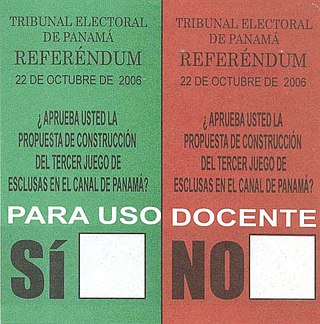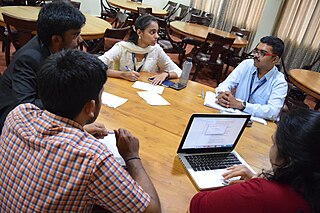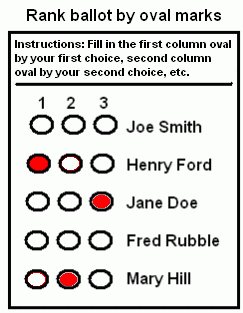
Voting is a method by which a group, such as a meeting or an electorate, convenes together for the purpose of making a collective decision or expressing an opinion usually following discussions, debates or election campaigns. Democracies elect holders of high office by voting. Residents of a jurisdiction represented by an elected official are called "constituents", and the constituents who choose to cast a ballot for their chosen candidate are called "voters." There are different systems for collecting votes, but while many of the systems used in decision-making can also be used as electoral systems, any which cater to proportional representation can only be used in elections.

Consensus decision-making or consensus process are group decision-making processes in which participants develop and decide on proposals with the goal of acceptance by all. The focus on establishing agreement of at least the majority or the supermajority and avoiding unproductive opinion differentiates consensus from unanimity, which requires all participants to support a decision.
Cumulative voting is a multiple-winner method intended to promote more proportional representation than winner-take-all elections such as block voting or first past the post. Cumulative voting is used frequently in corporate governance, where it is mandated by some (7) U.S. states (see e.g., Minn. Stat. Sec. 302A.111 subd. 2 .).

A focus group is a group interview involving a small number of demographically similar people or participants who have other traits/experiences in common depending on the research objective of the study. Their reactions to specific researcher/evaluator-posed questions are studied. Focus groups are used in market research to understand better people's reactions to products or services or participants' perceptions of shared experiences. The discussions can be guided or open. In market research, focus groups can explore a group's response to a new product or service. As a program evaluation tool, they can elicit lessons learned and recommendations for performance improvement. The idea is for the researcher to understand participants' reactions. If group members are representative of a larger population, those reactions may be expected to reflect the views of that larger population. Thus, focus groups constitute a research or evaluation method that researchers organize to collect qualitative data through interactive and directed discussions.

Stationery refers to commercially manufactured writing materials, including cut paper, envelopes, writing implements, continuous form paper, and other office supplies. Stationery includes materials to be written on by hand or by equipment such as computer printers.
The Delphi method or Delphi technique is a structured communication technique or method, originally developed as a systematic, interactive forecasting method which relies on a panel of experts. The technique can also be adapted for use in face-to-face meetings, and is then called mini-Delphi. Delphi has been widely used for business forecasting and has certain advantages over another structured forecasting approach, prediction markets.

In its most common sense, methodology is the study of research methods. However, the term can also refer to the methods themselves or to the philosophical discussion of associated background assumptions. A method is a structured procedure for bringing about a certain goal, like acquiring knowledge or verifying knowledge claims. This normally involves various steps, like choosing a sample, collecting data from this sample, and interpreting the data. The study of methods concerns a detailed description and analysis of these processes. It includes evaluative aspects by comparing different methods. This way, it is assessed what advantages and disadvantages they have and for what research goals they may be used. These descriptions and evaluations depend on philosophical background assumptions. Examples are how to conceptualize the studied phenomena and what constitutes evidence for or against them. When understood in the widest sense, methodology also includes the discussion of these more abstract issues.
An electronic meeting system (EMS) is a type of computer software that facilitates creative problem solving and decision-making of groups within or across organizations. The term was coined by Alan R. Dennis et al. in 1988. The term is synonymous with group support systems (GSS) and essentially synonymous with group decision support systems (GDSS). Electronic meeting systems form a class of applications for computer supported cooperative work.
Futures techniques used in the multi-disciplinary field of futurology by futurists in Americas and Australasia, and futurology by futurologists in EU, include a diverse range of forecasting methods, including anticipatory thinking, backcasting, simulation, and visioning. Some of the anticipatory methods include, the delphi method, causal layered analysis, environmental scanning, morphological analysis, and scenario planning.

Research design refers to the overall strategy utilized to carry out research that defines a succinct and logical plan to tackle established research question(s) through the collection, interpretation, analysis, and discussion of data.
Joint application design (JAD) is a process used in the life cycle area of the dynamic systems development method (DSDM) to collect business requirements while developing new information systems for a company. "The JAD process also includes approaches for enhancing user participation, expediting development, and improving the quality of specifications." It consists of a workshop where "knowledge workers and IT specialists meet, sometimes for several days, to define and review the business requirements for the system." The attendees include high level management officials who will ensure the product provides the needed reports and information at the end. This acts as "a management process which allows Corporate Information Services (IS) departments to work more effectively with users in a shorter time frame".
The nominal group technique (NGT) is a group process involving problem identification, solution generation, and decision making. It can be used in groups of many sizes, who want to make their decision quickly, as by a vote, but want everyone's opinions taken into account. The method of tallying is the difference. First, every member of the group gives their view of the solution, with a short explanation. Then, duplicate solutions are eliminated from the list of all solutions, and the members proceed to rank the solutions, 1st, 2nd, 3rd, 4th, and so on.
California Speaks was a statewide deliberative forum on health care reform that took place on August 11, 2007 in eight counties in California: Humboldt, Sacramento, Alameda (Oakland), Fresno, San Luis Obispo, Los Angeles, Riverside and San Diego. Nearly 3,500 people representing all segments of the population were randomly recruited to participate in this day-long discussion of health care reform proposals that are before the California legislature.
"Choosing Healthplans All Together" (CHAT) is the name given to a simulation exercise in which players decide which benefit types they would like to include in their health insurance package, and what level of service they prioritize. This activity emphasizes the critical need to design health insurance benefit packages based on local information. The core goal of this exercise is to ascertain which benefit package best reflects the priorities of the group of players within a finite budget allocated for health insurance and within the circumstances in which the participants live.
Group decision-making is a situation faced when individuals collectively make a choice from the alternatives before them. The decision is then no longer attributable to any single individual who is a member of the group. This is because all the individuals and social group processes such as social influence contribute to the outcome. The decisions made by groups are often different from those made by individuals. In workplace settings, collaborative decision-making is one of the most successful models to generate buy-in from other stakeholders, build consensus, and encourage creativity. According to the idea of synergy, decisions made collectively also tend to be more effective than decisions made by a single individual. In this vein, certain collaborative arrangements have the potential to generate better net performance outcomes than individuals acting on their own. Under normal everyday conditions, collaborative or group decision-making would often be preferred and would generate more benefits than individual decision-making when there is the time for proper deliberation, discussion, and dialogue. This can be achieved through the use of committee, teams, groups, partnerships, or other collaborative social processes.
Absolute probability judgement is a technique used in the field of human reliability assessment (HRA), for the purposes of evaluating the probability of a human error occurring throughout the completion of a specific task. From such analyses measures can then be taken to reduce the likelihood of errors occurring within a system and therefore lead to an improvement in the overall levels of safety. There exist three primary reasons for conducting an HRA; error identification, error quantification and error reduction. As there exist a number of techniques used for such purposes, they can be split into one of two classifications; first generation techniques and second generation techniques. First generation techniques work on the basis of the simple dichotomy of 'fits/doesn't fit' in the matching of the error situation in context with related error identification and quantification and second generation techniques are more theory based in their assessment and quantification of errors. 'HRA techniques have been utilised in a range of industries including healthcare, engineering, nuclear, transportation and business sector; each technique has varying uses within different disciplines.
Real-time Delphi (RTD) is an advanced form of the Delphi method. The advanced method "is a consultative process that uses computer technology" to increase efficiency of the Delphi process.
An online interview is an online research method conducted using computer-mediated communication (CMC), such as instant messaging, email, or video. Online interviews require different ethical considerations, sampling and rapport than practices found in traditional face-to-face (F2F) interviews. Online interviews are separated into synchronous online interviews, for example via online chat which happen in 'real time' online and asynchronous online interviews, for example via email conducted in non-real time. Some authors discuss online interviews in relation to online focus groups whereas others look at online interviews as separate research methods. This article will only discuss online interviews.
Literature Circles in EFL are teacher accompanied classroom discussion groups among English as a foreign language learners, who regularly get together in class to speak about and share their ideas, and comment on others' interpretations about the previously determined section of a graded reader in English, using their 'role-sheets' and 'student journals' in collaboration with each other.

The term ranked voting, also known as preferential voting or ranked choice voting, pertains to any voting system where voters use a rank to order candidates or options—in a sequence from first, second, third, and onwards—on their ballots. Ranked voting systems vary based on the ballot marking process, how preferences are tabulated and counted, the number of seats available for election, and whether voters are allowed to rank candidates equally. An electoral system that utilizes ranked voting employs one of numerous counting methods to determine the winning candidate or candidates. Additionally, in some ranked voting systems, officials mandate voters to rank a specific number of candidates, sometimes all; while in others, voters may rank as many candidates as they desire.






